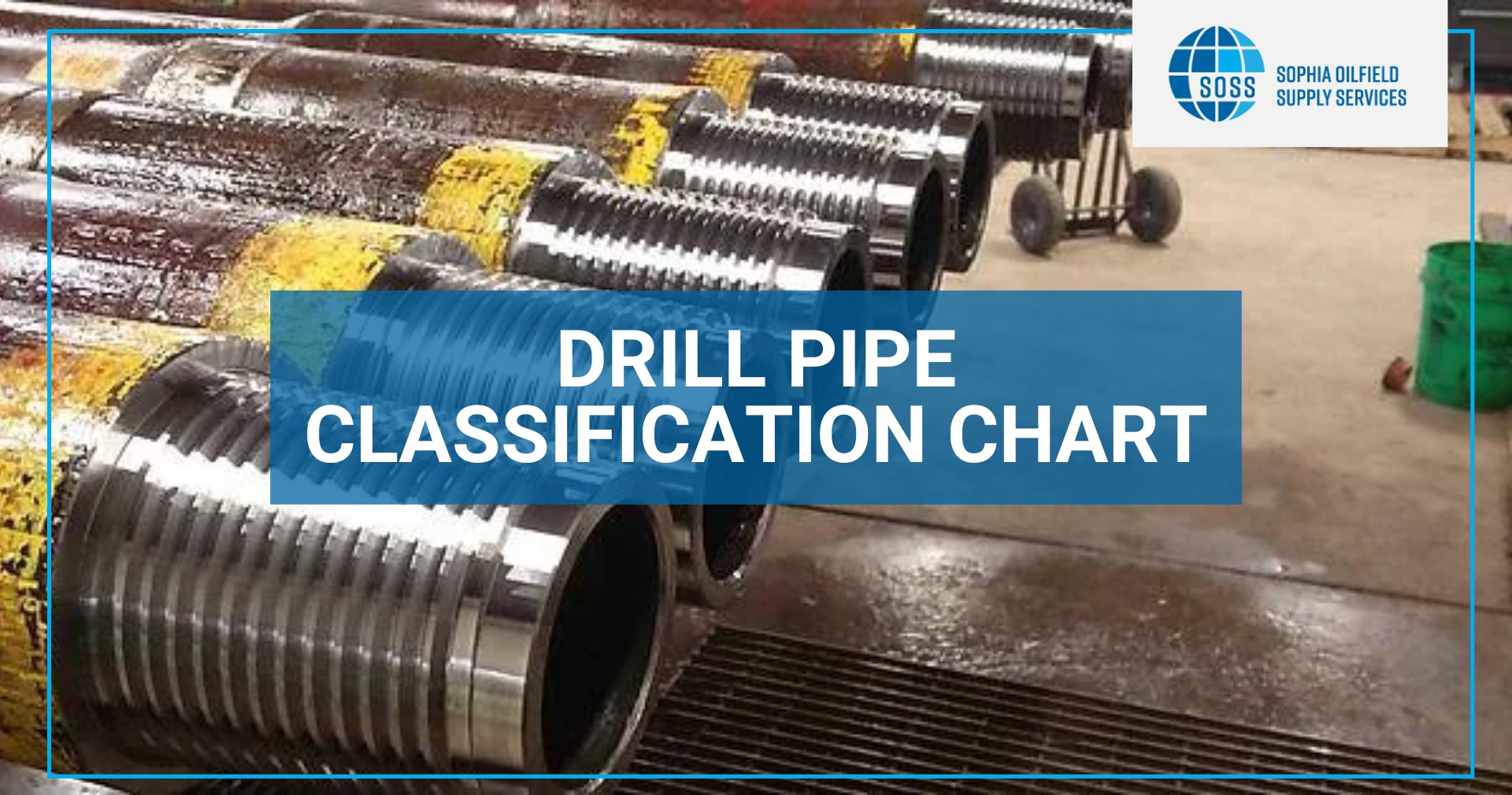| Class | Condition | Description | Remaining Wall Thickness |
| New (N) | Unused drill pipe | Brand new pipe that has never been used | 100% |
| Premium (P) | Slightly used drill pipe | Excellent condition pipe with little to no wear | >80% |
| C | Used drill pipe | Used extensively and deployed in less demanding drilling scenarios | <70% |
A drill pipe body is manufactured according to specifications outlined by the American Petroleum Institute (API). Adhering to the drill pipe classification chart and specified standards is essential to maintain drilling efficiency on the oilfield by minimizing the risk of failures, which could otherwise lead to serious safety hazards and nonproductive time.
The API Spec 5D states the standards and requirements for manufacturing, inspecting, and classifying drill pipe. The alloy steel pipe can be classified in diverse aspects under API Spec 5D, which we will discuss in this article. Read on to learn more!
Drill Pipe Function
A drill pipe is among the most vital equipment used in the oilfield to extract oil and gas, playing a pivotal role in the drilling process as a core part of the drill string.
The seamless steel pipe functions in extreme conditions like high temperatures and corrosive environments and endures severe loads while maintaining its shape and integrity.
The hollow steel pipe transmits torque received from the drill string and rotates the bit to penetrate the surface.
It also circulates drilling mud in the wellbore and up the annulus or wellbore. The drilling fluid flows through the drill pipe to the drill bit at the bottom. It separates the rock cuttings and carries them to the surface while cooling and lubricating the bit.
As the drill pipe must function in extreme environments and endure significant pressures and strains, the risk of failure is always present. That means that following the classifications as stated by the API is indispensable to minimize the risk of unexpected outcomes and ensure safety and efficiency on the oilfield.
Drill pipe classifications are vital to match the correct type of drill pipe suited for specific drilling conditions and needs, including the type, appropriate class, material grade, and length range.
Drill Pipe Types
A drill pipe can be categorized as a standard drill pipe or heavyweight drill pipe.
Our heavy weight drill pipe for sale features heavy, twice as thick walls and has a higher weight and torsional strength than the regular drill pipe.
It is placed as a transition between the drill collar and the standard drill pipe to minimize stress concentration between these two components. It also adds weight to the drill string while offering more stability during challenging drilling operations. That helps the drill bit cut through the formation better and reduces the chances of drill string fatigue failure despite undergoing extreme stress and pressure.
Drill Pipe Classes
As the drill pipe is exposed to harsh conditions on the oilfield, periodic inspections are essential to maintain its structural integrity and the safety of the oil rig personnel.
During maintenance and inspection, drill pipe classes are the primary classification used to determine the overall condition of the drill pipe, including the corrosion, wear, and any defects it has endured. Simply put, measuring the thickness of the wall or outer diameter dictates the specific class an oilfield pipe falls under, as the wall thickness gradually erodes with usage.
Based on the inspection results, the API drill pipe can be classified under the following three categories, defining its quality as determined by the remaining wall thickness:
Class 1 (New Class)
A class 1 drill pipe is brand new and has never been used in the oil well. It is in excellent shape as it has not undergone any wear or damage and is the most robust and highest-quality pipe in its original condition.
Premium (P Class)
A premium drill pipe is almost as good as new and has experienced minimal or no wear. Its remaining wall thickness is at least 80% of a brand new pipe. Premium pipes are the most common drill pipe used in the oil and gas industry today due to their reliability and cost-effectiveness.
C class
A C class pipe has suffered significant wear and tear. It has thinner walls, and the thickness is less than 70% of the new wall. It can be further divided into C1, C2, and C3, based on the physical condition. The outer diameter has reduced so much that the pipe has reached or is almost at the end of its service life.
This type of pipe is suitable for less demanding drilling operations where high strength is not the primary requirement.
Drill Pipe Material Grades
| Material Grade | Yield Strength (psi) | Tensile Strength (psi) |
| E-75 | 75000-105000 | 100000 |
| X-95 | 95000-125000 | 105000 |
| G-105 | 105000-135000 | 115000 |
| S-135 | 135000-165000 | 145000 |
A drill pipe is generally made from high-strength steel alloy and can be classified based on the type of steel grade used to manufacture it, which defines its strength. The four API grades a drill pipe can be classified under include E75, X95, G105, and S135.
Each grade features a different yield and tensile strength, indicating its ability to withstand maximum drilling stresses before deforming or breaking. These grades can be categorized as low strength and high strength.
Accordingly, that helps choose the suitable oil drill pipe to match the specific drilling application.
Low Strength
A grade E drill pipe is made of mainly carbon steel and features a relatively low yield strength of 75000-105000 psi and tensile strength of 100000 psi. However, it offers good durability by withstanding moderate loads and is suitable for drilling medium-depth wells up to 15,000 feet deep.
High Strength
Grades X, G, and S are high-strength pipes made of alloy steel. X-95 has a minimum yield strength ranging from 95000-125000 psi, and a tensile strength of 105000 psi. G-105 features a yield strength of 105000-135000 psi and a tensile strength of 115000. Lastly, S-135 is the most robust grade, with a yield strength from 135000-165000 psi and a tensile strength of 145000 psi.
Grades G and S are typically used for tougher drilling operations, such as horizontal and directional drilling.
A higher drill pipe grade corresponds to enhanced strength and toughness and is suited for a highly demanding drilling operation at higher depths. They offer more resistance to extreme strain and stresses while providing excellent durability and resistance to fracture.
Drill Pipe Length Ranges
| Range | Length (feet) |
| Range 1 | 18-22 |
| Range 2 | 27-30 |
| Range 3 | 38-45 |
The drill pipe comes in different lengths based on the drilling requirements. The depth of the well determines the length range to use. The three main API drill pipe length ranges include:
Range 1
A range 1 drill pipe is the shortest at 18-22 feet long, often deployed in shallow oil wells.
Range 2
Range 2 is the standard drill pipe length and is 27-30 feet long. This steel pipe is the most common in the oilfield industry due to its versatility.
Range 3
A range 3 steel pipe is seldom used and features the lowest number of tool joint connections due to its increased length. This type of drilling pipe is 38-45 feet in length and is used for deep-water drilling.
The longer length means it has fewer tool joints at the ends of the drill pipe to connect different sections. The downside of a range 3 steel pipe is that it wears out faster due to higher load and stress on each tool joint, reducing its overall service life.
Drill Pipe Manufacturing Methods
Depending on the weld type, there are three main drill pipe manufacturing methods. These include:
Seamless
A seamless drill pipe is manufactured without any welded seams or joints and features high strength and longevity, making it a viable choice for harsh drilling environments.
ERW (Electric Resistance Welded)
The ERW drill pipe is created by rolling and welding hot rolled coils or steel sheets. It offers more cost-effectiveness but is only ideal for less challenging operations.
SAW (Submerged Arc Welded)
A SAW drill pipe is made by welding steel plates into a round shape under a layer of flux. SAW drill pipe is more robust and suited for drilling applications where high strength and resistance are paramount.
About Sophia Oilfield Supply Services
SOSSUSA is a trusted and leading distributor of top quality drilling products and equipment manufactured in accordance with the highest industry standards. We have been providing new and used drill pipe for sale for more than three decades that meet the diverse drilling requirements of our valued customers.
By selecting a drill pipe with the appropriate classification range, you can ensure optimal performance on the oilfield with minimal risk of failures and maximum efficiency.
Contact us today for a customized quote for our drill pipe, and our team of experts will assist you in choosing the drill pipe with the classification that suits your specific drilling needs.

